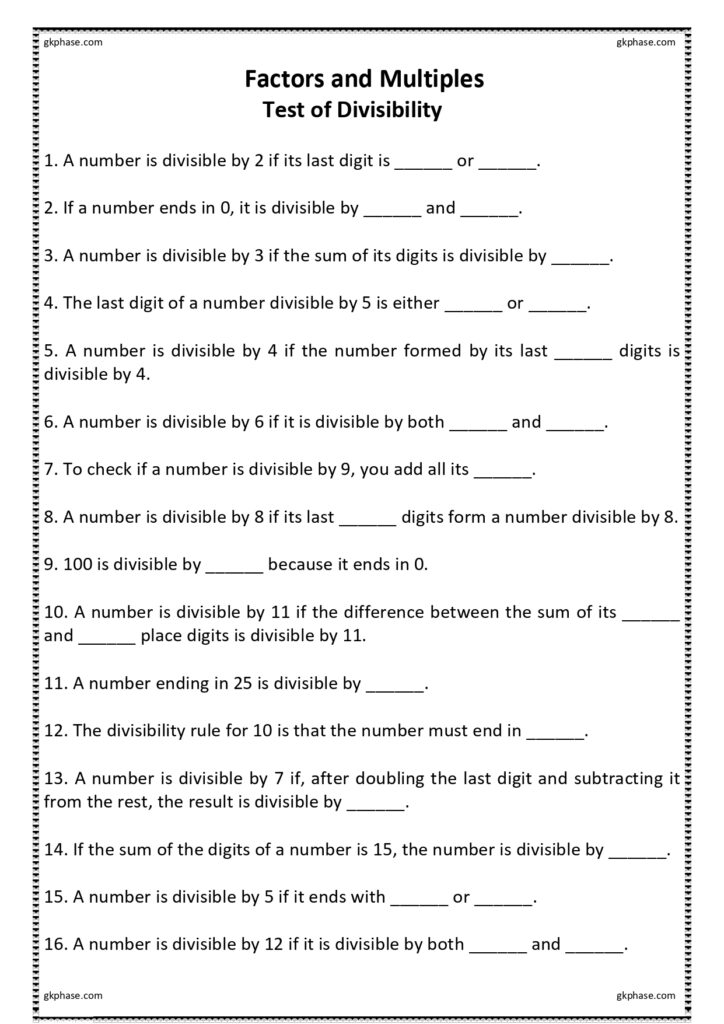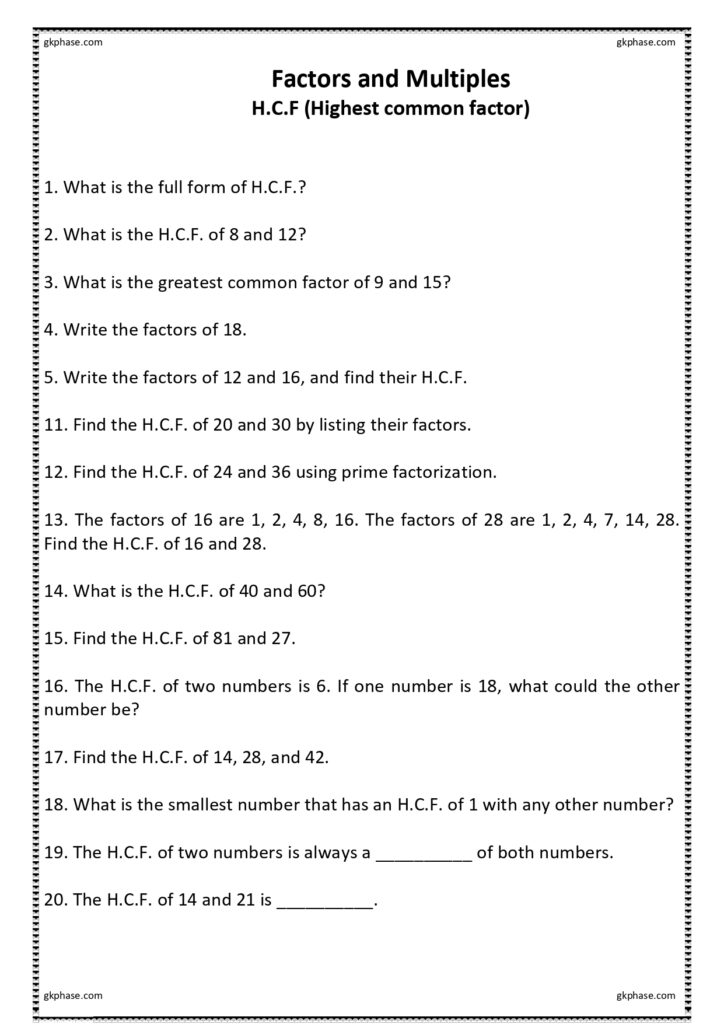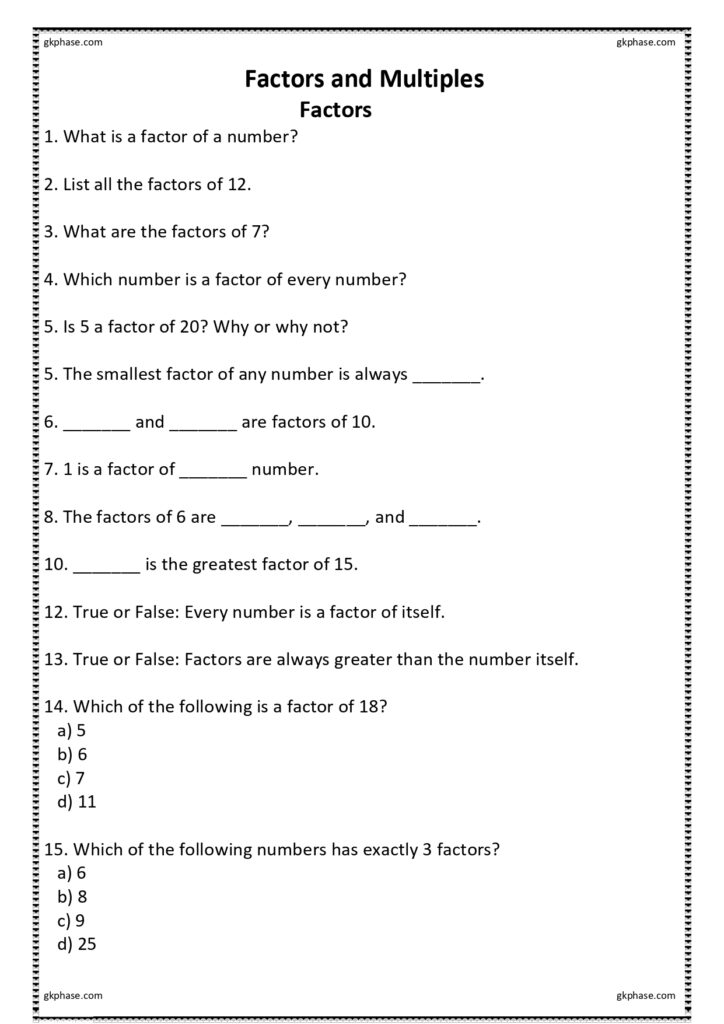Class 5
Factors and Multiples
1. Factors
Definition:
A factor is a number that divides another number exactly (without leaving a remainder).
Example:
For the number 12:
- Factors of 12 are: 1, 2, 3, 4, 6, 12
- Explanation:
- 1 × 12 = 12
- 2 × 6 = 12
- 3 × 4 = 12
- These pairs show that 1, 2, 3, 4, 6, and 12 divide 12 completely.
Properties of Factors:
- Every number has at least two factors: 1 and itself.
- Factors are always less than or equal to the number.
- The smallest factor of any number is 1, and the largest is the number itself.
- Factors are whole numbers.
2. Multiples
Definition:
A multiple is the result of multiplying a number by an integer.
Example:
For the number 5:
- Multiples of 5 are: 5, 10, 15, 20, 25, 30, … (and so on)
- Explanation:
- 5 × 1 = 5
- 5 × 2 = 10
- 5 × 3 = 15
- These are all multiples of 5.
Properties of Multiples:
- Every number has infinite multiples.
- The smallest multiple of any number is the number itself.
- Multiples are greater than or equal to the number.
- Zero is a multiple of every number (e.g., 5 × 0 = 0).
Difference Between Factors and Multiples:
| Aspect | Factors | Multiples |
|---|---|---|
| Definition | Numbers that divide another number exactly. | Numbers obtained by multiplying a number. |
| Example | Factors of 10: 1, 2, 5, 10 | Multiples of 4: 4, 8, 12, 16, 20, … |
| Number Count | Finite (limited) | Infinite (unlimited) |
| Size | Smaller than or equal to the number. | Greater than or equal to the number. |
Test of divisibility
Divisibility Rules:
1. Divisibility by 2
- Rule: A number is divisible by 2 if its last digit is 0, 2, 4, 6, or 8.
- Example:
- 14 → Last digit is 4 → Divisible by 2
- 27 → Last digit is 7 → Not divisible by 2
2. Divisibility by 3
- Rule: A number is divisible by 3 if the sum of its digits is divisible by 3.
- Example:
- 123 → Sum of digits: 1 + 2 + 3 = 6 → 6 is divisible by 3 → 123 is divisible by 3
- 145 → Sum of digits: 1 + 4 + 5 = 10 → 10 is not divisible by 3 → 145 is not divisible by 3
3. Divisibility by 4
- Rule: A number is divisible by 4 if the last two digits form a number divisible by 4.
- Example:
- 316 → Last two digits: 16 → 16 ÷ 4 = 4 → Divisible by 4
- 725 → Last two digits: 25 → 25 ÷ 4 = 6 remainder 1 → Not divisible by 4
4. Divisibility by 5
- Rule: A number is divisible by 5 if its last digit is 0 or 5.
- Example:
- 45 → Last digit is 5 → Divisible by 5
- 102 → Last digit is 2 → Not divisible by 5
5. Divisibility by 6
- Rule: A number is divisible by 6 if it is divisible by both 2 and 3.
- Example:
- 72 → Divisible by 2 (ends in 2) and by 3 (7 + 2 = 9) → Divisible by 6
- 25 → Not divisible by 2 → Not divisible by 6
6. Divisibility by 8
- Rule: A number is divisible by 8 if the last three digits form a number divisible by 8.
- Example:
- 1,000 → Last three digits: 000 → 0 is divisible by 8 → Divisible by 8
- 234 → Last three digits: 234 → 234 ÷ 8 = 29 remainder 2 → Not divisible by 8
7. Divisibility by 9
- Rule: A number is divisible by 9 if the sum of its digits is divisible by 9.
- Example:
- 729 → Sum of digits: 7 + 2 + 9 = 18 → 18 is divisible by 9 → 729 is divisible by 9
- 123 → Sum of digits: 1 + 2 + 3 = 6 → 6 is not divisible by 9 → Not divisible by 9
8. Divisibility by 10
- Rule: A number is divisible by 10 if its last digit is 0.
- Example:
- 150 → Last digit is 0 → Divisible by 10
- 123 → Last digit is 3 → Not divisible by 10
9. Divisibility by 11
- Rule: A number is divisible by 11 if the difference between the sum of digits in odd positions and the sum of digits in even positions is divisible by 11 (including 0).
- Example:
- 121 → (1 + 1) – 2 = 0 → 0 is divisible by 11 → 121 is divisible by 11
- 234 → (2 + 4) – 3 = 3 → Not divisible by 11
H.C.F (Highest common factor)
The Highest Common Factor (HCF) of two or more numbers is the largest number that divides each of them exactly without leaving a remainder. It’s also called the Greatest Common Divisor (GCD).
Steps to Find HCF:
Method 1: Listing Factors
- List all the factors of each number.
- Identify the common factors.
- The largest common factor is the HCF.
Example: Find the HCF of 12 and 18.
- Factors of 12: 1, 2, 3, 4, 6, 12
- Factors of 18: 1, 2, 3, 6, 9, 18
- Common factors: 1, 2, 3, 6
- HCF = 6
Method 2: Prime Factorization
- Write the prime factorization of each number.
- Identify the common prime factors.
- Multiply the common prime factors to find the HCF.
Example: Find the HCF of 24 and 36.
- Prime factors of 24: 2×2×2×3
- Prime factors of 36: 2×2×3×3
- Common prime factors: 2x2x3
- HCF = 2x2x3=12
Method 3: Division Method
- Divide the larger number by the smaller number.
- Take the remainder and divide it into the previous divisor.
- Repeat until the remainder is 0. The last divisor is the HCF.
Example: Find the HCF of 48 and 18.
- 48÷18 = 2 remainder 12
- 18÷12= 1 remainder 6
- 12÷6=2 remainder 0
- HCF = 6
Welcome to gkphase
To download free printable activities and worksheet of Factors & Multiples (class 5th maths) in PDF form

























